For the 2025 school year, there is 1 public preschool serving 450 students in Valley Local School District. This district's average pre testing ranking is 7/10, which is in the top 50% of public pre schools in Ohio.
Public Preschool in Valley Local School District have an average math proficiency score of 72% (versus the Ohio public pre school average of 48%), and reading proficiency score of 67% (versus the 53% statewide average).
Minority enrollment is 7% of the student body (majority Hispanic), which is less than the Ohio public preschool average of 39% (majority Black).
Overview
This School District
This State (OH)
# Schools
3 Schools
839 Schools
# Students
1,030 Students
334,112 Students
# Teachers
58 Teachers
18,897 Teachers
Student : Teacher Ratio
18:1
18:1
District Rank
Valley Local School District, which is ranked within the top 50% of all 918 school districts in Ohio (based off of combined math and reading proficiency testing data) for the 2021-2022 school year.
The school district's graduation rate of 90-94% has decreased from 95% over five school years.
Overall District Rank
#339 out of 929 school districts
(Top 50%)
(Top 50%)
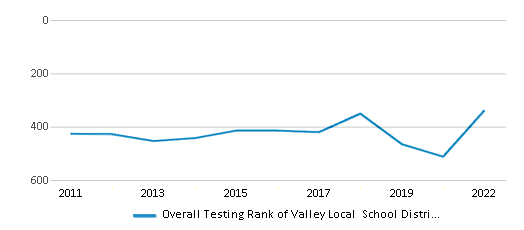
Math Test Scores (% Proficient)
59%
52%
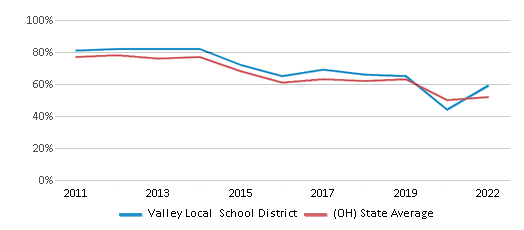
Reading/Language Arts Test Scores (% Proficient)
62%
60%
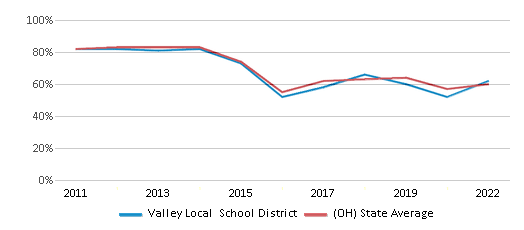
Science Test Scores (% Proficient)
71%
63%
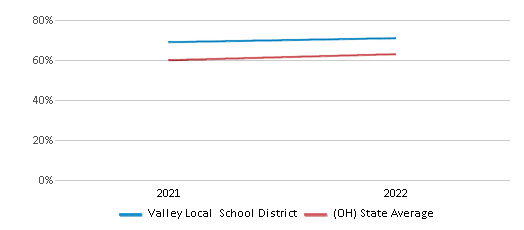
Graduation Rate
90-94%
86%
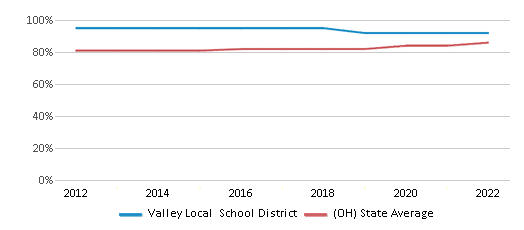
Students by Ethnicity:
Diversity Score
0.12
0.58
# American Indian Students
1 Student
462 Students
% American Indian Students
n/a
n/a
# Asian Students
n/a
8,061 Students
% Asian Students
n/a
3%
# Hispanic Students
24 Students
30,384 Students
% Hispanic Students
2%
9%
# Black Students
2 Students
67,190 Students
% Black Students
n/a
20%
# White Students
964 Students
204,949 Students
% White Students
94%
61%
# Hawaiian Students
n/a
329 Students
% Hawaiian Students
n/a
n/a
# Two or more races Students
39 Students
22,737 Students
% of Two or more races Students
4%
7%
Students by Grade:
# Students in PK Grade:
32
45,802
# Students in K Grade:
103
55,948
# Students in 1st Grade:
86
51,388
# Students in 2nd Grade:
71
49,073
# Students in 3rd Grade:
78
40,515
# Students in 4th Grade:
80
38,905
# Students in 5th Grade:
75
30,860
# Students in 6th Grade:
79
12,193
# Students in 7th Grade:
65
4,329
# Students in 8th Grade:
80
4,221
# Students in 9th Grade:
86
368
# Students in 10th Grade:
74
211
# Students in 11th Grade:
50
188
# Students in 12th Grade:
71
111
# Ungraded Students:
-
-
District Revenue and Spending
The revenue/student of $14,867 in this school district is less than the state median of $17,287. The school district revenue/student has stayed relatively flat over four school years.
The school district's spending/student of $11,898 is less than the state median of $17,235. The school district spending/student has stayed relatively flat over four school years.
Total Revenue
$15 MM
$28,879 MM

Spending
$12 MM
$28,792 MM
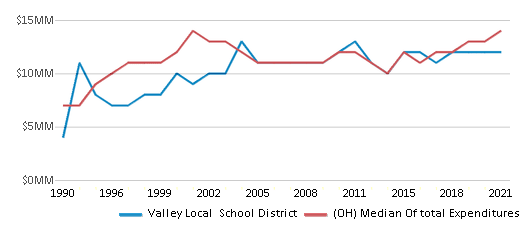
Revenue / Student
$14,867
$17,287
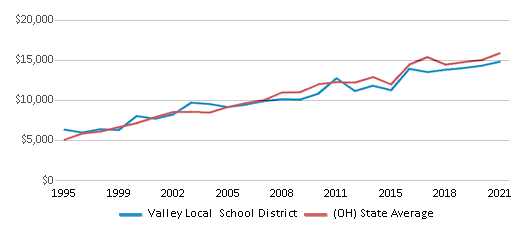
Spending / Student
$11,898
$17,235
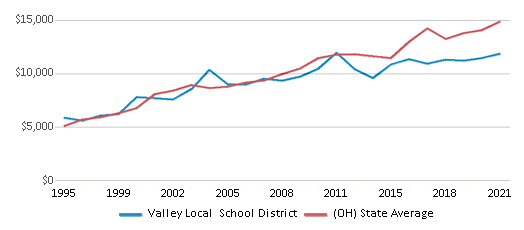
Best Valley Local School District Public Preschools (2025)
School
(Math and Reading Proficiency)
(Math and Reading Proficiency)
Location
Grades
Students
Rank: #11.
Valley Elementary School
(Math: 70-74% | Reading: 65-69%)
Rank:
Rank:
8/
Top 30%10
1821a State Route 728
Lucasville, OH 45648
(740) 259-2611
Lucasville, OH 45648
(740) 259-2611
Grades: PK-4
| 450 students
Recent Articles

What Is A Charter School?
Explore the world of charter schools in this comprehensive guide. Learn about their history, how they operate, and the pros and cons of this educational innovation. Discover key facts about charter schools, including admission policies, demographics, and funding, as well as what to look for when considering a charter school for your child.

10 Reasons Why High School Sports Benefit Students
Discover the 10 compelling reasons why high school sports are beneficial for students. This comprehensive article explores how athletics enhance academic performance, foster personal growth, and develop crucial life skills. From improved fitness and time management to leadership development and community representation, learn why participating in high school sports can be a game-changer for students' overall success and well-being.

February 05, 2025
Understanding the U.S. Department of Education: Structure, Impact, and EvolutionWe explore how the Department of Education shapes American education, from its cabinet-level leadership to its impact on millions of students, written for general audiences seeking clarity on this vital institution.





